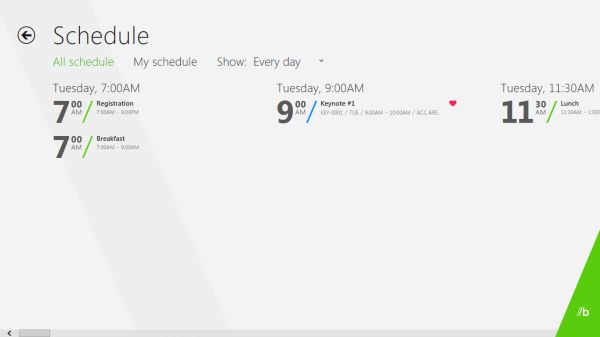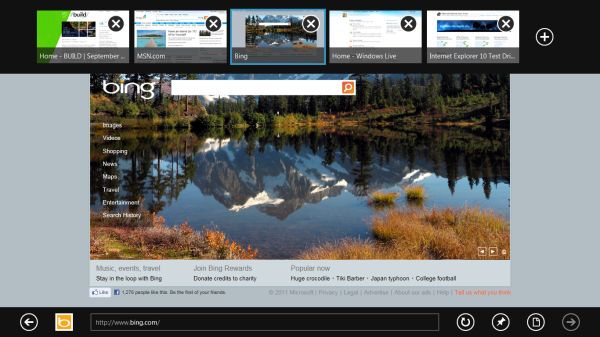Microsoft BUILD: Windows 8, A Pre-Beta Preview
by Brian Klug & Ryan Smith on September 13, 2011 12:05 PM EST- Posted in
- BUILD
- Windows
- Microsoft
- Windows 8
- Trade Shows
The Desktop User Experience & Business Use
While we’re primarily focusing on Windows 8 as a tablet OS since the hardware we used was a tablet, we also wanted to evaluate it some as a desktop OS. As the sample tablet was compatible with Bluetooth peripherals, we were able to pull out a BT keyboard and mouse and use it like a traditional laptop/desktop environment. With that said I’d like to preface our impressions with the following: as it stands Windows 8 is clearly focused on tablets first and Microsoft’s presentation was equally tablet focused, and it’s almost certain the experience will change before Windows 8 ships.
Overall Windows 8 is extremely jarring right now from a desktop user perspective. Metro is the Windows shell, no ifs ands or butts. Metro applications can only be accessed through the Metro shell (i.e. the Start Screen), and the Metro shell is always what the tablet will boot up into. Explorer as we know it is the Metro shell – if you kill it, you kill Metro shell with it – so at this time it’s not possible to boot up into the traditional Windows desktop. Even if you could, the Start Menu is gone, replaced with Metro charms.
So what we’re really evaluating is the ability to use the Metro shell and Metro applications with a mouse. For all the good Microsoft has done implementing multi-touch, the mouse has clearly suffered as it currently stands. Click & drag does not operate the same as tap & drag, which creates some oddities when you want to scroll around. In fact scrolling is probably the biggest oversight right now, as the Metro style dictates applications are laid out left-to-right rather than top-to-bottom. The mouse wheel will (slowly) scroll through tiles on the Start Screen, but in other places such as the Microsoft BUILD application the mouse wheel is useless. In its place you have to drag a scroll bar around, which is about as fun as it was prior to mice coming with a wheel.
Internet Explorer is particularly weird. Because it takes the full screen approach there isn’t a menu bar to speak of, and the tabs and URL bar are hidden. Invoking them requires right-clicking, with right-clicking pulling double duty as a way to open a link in a new tab and invoking the various bars. This also means that right-clicking for other purposes (e.g. View Source, etc) are unavailable.
The good news is that most of the traditional keyboard shortcuts still work, including Alt-Tab, WinKey + D, WinKey + E, and Ctrl-Alt-Esc. You can even Alt-Tab between launched Metro applications. The Start Menu search bar is also faithfully replicated on the Start Screen, so when you start typing Windows 8 will start narrowing down results of things to open. So overall keyboard users maintain much of their advantage in quickly executing applications. At the same time we’ve encountered fields that we can’t tab to, so not everything is working as it should.
While we’ve only had a short period of time work play with Windows 8 with a mouse and keyboard, at this point in time there’s not a lot to say that’s positive. Metro works well as a tablet interface, but with a mouse and keyboard it’s like using a tablet with a mouse and keyboard. Hopefully Microsoft will have a more suitable mouse & keyboard control scheme ready to go for Windows 8 farther down the line.
Windows 8 the Business OS
So far Microsoft has been focused on the consumer side of Windows 8, but business users won’t be left out in the cold. Windows 8 will also be the basis of a new version of Windows Server (also using Metro), and Windows 8 clients will have some new features.
The business additions announced so far for Windows 8 revolve around Remote Desktop and Hyper-V. Windows 8 Remote Desktop includes proper support for multi-touch controls, so tablets and other touch devices will be able to RDP into other machines and correctly interact with them. Meanwhile Windows 8 will add support for Hyper-V (previously it was Server-only), allowing Windows clients to spawn virtualized instances of Windows through the Hyper-V hypervisor.
Microsoft also used their discussion on the business side of Windows 8 to announce that Windows 8 will support installation onto and booting off of a USB drive, allowing business users to carry their copy of Windows with them. This has been a repeatedly requested feature for many years from more than just business users, so hopefully it will be everything everyone has always wanted.












235 Comments
View All Comments
Booster - Thursday, September 15, 2011 - link
It's the ribbon again, but infinitely worse. Metro is just outright stupid, that is.I remember watching a presentation by Julie Larson-Green where she pitched the ribbon back in 2006. IIRC she said that they listened to the users and created the ribbon according to their usage scenarios. So according to her the ribbon was next best thing since sliced bread.
Who were they listening to? The ribbon looks better give or take, but it's less useful in the workflow, it's less effective, it's just plain worse than the old concept. That division of MS doesn't listen to users, it's like a dictatorship in which we have to use our PCs the way that madam wants us to. But she doesn't do any actual work on the PC like me for example. Hell, you can't even preview a page or print without setting up the ribbon, where's the usability? Why do I have to scroll between all those damn tiles?
This Windows 8 fiasco is where MS finally needs to realize the situation and finally take the matters well in hand.
archer75 - Thursday, September 15, 2011 - link
You do realize you don't have to use the metro tile UI right? You can boot right in to a traditional desktop like you are used to.Plenty of updates here for the desktop user.
Really this new metro UI just provides a better layer for tablets but the OS is still there which i'm really pumped about. I don't know how often i've been using my ipad and wishing I could access a real OS on it.
Moricon - Friday, September 16, 2011 - link
"Overall Windows 8 is extremely jarring right now from a desktop user perspective. Metro is the Windows shell, no ifs ands or butts. Metro applications can only be accessed through the Metro shell (i.e. the Start Screen), and the Metro shell is always what the tablet will boot up into. Explorer as we know it is the Metro shell – if you kill it, you kill Metro shell with it – so at this time it’s not possible to boot up into the traditional Windows desktop. Even if you could, the Start Menu is gone, replaced with Metro charms."Metro IS the windows Shell--- METRO IS EXPLORER!!!!
Have you loaded the build, I have, played with it. IT SUCKS bigtime!
Microsoft will go back on this, the pressure will be to great from the desktop user!
There are improvements, better memory management, faster boot process, safer recovery options, faster work-flow (yes ribbon is actually better for non-power users, who use keyboard shortcuts.)
Why can they not just bring those improvements to th Win desktop version and leave metro to Tablets, Netbooks and ARM anyway.
My days of PC Gaming are coming to a close, most Games are crap! Looks seriously like Mint will become my main Work OS and I will keep a copy of WIN7 for my back catalog of games!
MrBungle123 - Friday, September 16, 2011 - link
How is this Metro crap going to work for those of us that make a living with a mouse and keyboard?I work in IT, I have to do everything from assisting users to writing programs. Its not uncommon for me to have Visual Studio, Outlook, IE, 2 databases, and 5 or 6 Remote Desktop connections going on at the same time.
There is no way in hell I'm putting this garbage on my work computer, nor am i going to install it on any of the desktops/servers connected to my network. This is a user training nightmare, the resistance to migrating to Vista from XP is nothing compared to what the resistance of migrating from Win7 to Win8 will be if the final product is anything like this.
talk2dfox - Friday, September 16, 2011 - link
Does anyone else think Windows 8 seems to have no coherent strategy?For users:
1) two different types of applications, which can't run side by side: what do you do if you are a business user who needs to switch efficiently between one application which is Metro-based and another which is not?
2) switch to the desktop and click on the start button and you're back at the Metro UI? huh? Are the only desktop applications I can start directly from the desktop UI the ones which have links on the desktop?
3) some settings are in the metro control panel, others in the old windows control panel
4) too many gestures which will be impossible to remember because they bear no relation to anything you've used before. The whole reason why the touch experience of iPhone et al has caught on (and why even small children catch on to it quickly) is that it is familiar. Want to move what's currently on the screen up? put your finger on it and move it up as if it were a physical object. Want to zoom? use two fingers to "stretch" or "shrink" the image. So, what's the comparable analogy in Metro for swiping up to select a button? There isn't any. Not that Microsoft had much choice - they're trying to graft a touch experience onto an existing Windows UI which has too many different functions without physical analogies, so some of them are bound to be mapped to something weird. But that's the point - trying to graft a touch experience onto the existing Windows UI is never going to produce something coherent and intuitive.
For developers:
5) yet another API, but all the old APIs (.net and win32) still supported (but only on x86, not ARM).
6) If you are starting to develop an application today, what should you use?
Will an app built for Windows Phone 7 today be portable to Metro (and sellable via the Windows 8 store)? If not, will it run at all on an ARM-based metro phone or tablet? What about an x86 based tablet or desktop?
What if you want to write an application to be used on Win 8 on all form factors? The only thing which will run on Win 8 on ARM will be Metro, but the development tools for Metro don't exist yet. Think about how far WP7 is behind iPhone and Android today, and then consider what the situation will be like for Win 8 which is just now reaching the point where Microsoft can demo the UI and talk about development.
Contrast this situation with iOS/OS X: With a single language (objective C), a single development environment (xcode), and two variants of essentially the same framework (Cocoa), you can target iPhone/iPad and Mac.